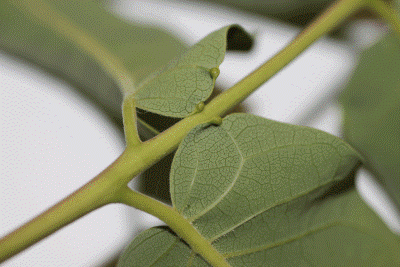Tree of Heaven (Ailanthus altissima)
by Audrey Harvey, Research Assistant at Montana State University

Figure 1: Tree of heaven, entire tree.
Introduction
Tree of heaven (Ailanthus altissima, also called Chinese sumac) is a rapidly growing tree native to China. It is considered a weedy plant growing in temperate regions across all continents except Antarctica. In the United States, it was introduced in 1784 as an ornamental plant in Pennsylvania and introduced again during the mid-1800s Gold Rush on the West Coast, and in Hawaii in 1924. The tree currently grows in 45 states. Tree of heaven has not been found in Montana, though nearby infestations are known in Idaho County, Idaho. It is a noxious weed in Oregon and Washington.
Identification and Biology
A member of the Simaroubaceae family, tree of heaven can grow up to 70 feet tall and 6 feet wide. It has distinct pinnately compound leaves that have a skunk-like odor and protruding glands on the backside (fig. 2). Leaf length is up 3 feet with 10-45 leaflets (fig. 3). The thin bark looks much like cantaloupe skin (fig. 4), with easily breakable twigs. The deep taproot gives rise to creeping roots that can emerge as far away as 50 feet from the trunk. As a dioecious (male or female) plant, female trees produce green-pale yellow flowers at 4-7 inches, maturing into winged fruit, called samaras, with 1-2 inch wind-dispersed seeds.

Figure 2: Glands on back of leaves.

Figure 3: Winged seed, or samara, of tree of heaven.

Figure 4: Bark looks similar to skin of cantaloupe.
Habitat and Spread
Found in dense thickets, tree of heaven’s annual production of 350,000 samaras per tree have led to its aggressive spread across rural and urban areas. In wildlands it has been found in forests, floodplains and riparian habitats, particularly favoring disturbed sites. The tree is tolerant of high pollution and both nutrient-rich and -poor soils, including acidic mining soils and volunteering between pavement cracks. In North America it is found in temperatures of 15-97°F, elevations of 700-7,000 feet and mean annual precipitation of 14-90 inches.
Impacts
Tree of heaven is one of the fastest growing trees in North America, where seedlings often outcompete native plants at 3-7 feet of growth in one year. The expansive root system can damage sidewalks, building foundations, and sewer systems. The leaves, roots, and bark are allelopathic with the toxin ailanthone and can reduce wildlife habitat by disrupting native plant communities.
Management Options
Prevention is key through proper identification and abstaining from ornamental plantings. Mechanical controls are only effective when the entire root is removed, otherwise cuttings are counterproductive and creeping roots will persist. Similarly, tree of heaven is known to flourish after top-kill by fire due to its ability to sprout by roots. Stem injections, basal bark, and/or cut stump treatments of either triclopyr, glyphosate, or imazapyr in the late summer to early fall are treatment options. Foliar applications of triclopyr, amnopyralid + triclopyr, glyphosate, and metsulfuron in summer to early fall (or onset of fall color) can also be effective. Specific herbicide label instructions are to be followed and subsequent monitoring is necessary. The Ailanthus webworm moth (Atteva aurea) will eat foliage, but its effectiveness is limited.
Further Information
For more information about Ailanthus altissima contact Extension Invasive Plants specialist Jane Mangold. Additional posts about invasive plants in Montana can be found in the Monthly Weed Post directory.
The Printable PDF (1.2MB) version of this post includes a quiz that is also available on the puzzle page.


